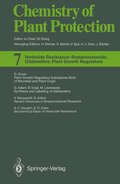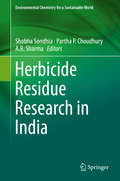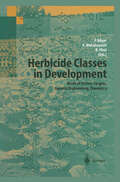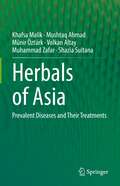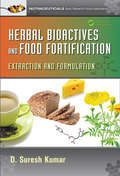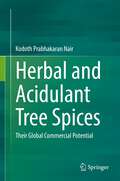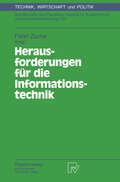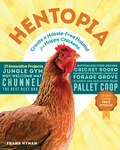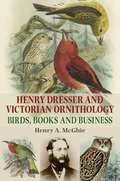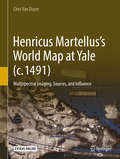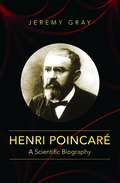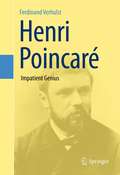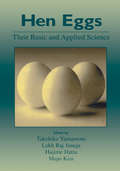- Table View
- List View
Herbicide Resistance — Brassinosteroids, Gibberellins, Plant Growth Regulators (Chemistry of Plant Protection #7)
by G. Adam S. O. Duke D. Gross M. Lischewski V. Marquardt K. C. Vaughn B. VoigtChemistry of Plant Protection, Volume 7, provides critical review articles on new aspects of herbicide resis- tance, serving the needs of research scientists, pesticide manufacturers, government regulators, agricultural practitioners.
Herbicide Residue Research in India (Environmental Chemistry for a Sustainable World #12)
by Shobha Sondhia Partha P. Choudhury A. R. SharmaHerbicides constitute about 60% of the total pesticides consumed globally. In India, the use of herbicides started initially in tea gardens and picked up in the 1970s, when the high-yielding varieties of rice and wheat were introduced. Presently, 67 herbicides are registered in the country for controlling weeds in crops including cereals, pulses, oilseeds, fibre and tuber crops, and also in the non-crop situations. These chemicals are becoming increasingly popular because of their efficiency and relatively low cost compared with manual or mechanical weeding operations. The contribution of herbicide to total pesticide use, which was only 10-15% during the first decade of the 21st century, has now increased to about 25% with an annual growth rate of 15-20%, which is much higher than insecticides and fungicides. Though the application of herbicides is minimizing yield loss to a great extent, their residues in the food chain and surface and groundwater create some environmental nuisance particularly to non-target organisms. Research on pesticide residues in India was started during 1970s, when such chemicals were introduced on a greater scale along with high-yielding variety seeds, irrigation and chemical fertilizers for increasing food production. However, the herbicide residue research was not given much emphasis until 1990s. The Indian Council of Agricultural Research initiated a national level programme known as All India Coordinated Research Project on Weed Management through the NRC-Weed Science as the main centre along with some centers of ICAR Institutes and state agricultural universities. Over the last two decades, adequate information was generated on estimation, degradation and mitigation of herbicide residues, which were documented in annual reports, bulletins, monographs and scientific articles. However, there was no consolidated compilation of all the available information providing a critical analysis of herbicide residues. Accordingly, an effort has been made in the publication to compile the available information on herbicide residues in India. This is the first report of its kind which presents the findings of herbicide residues and their interactions in the biotic and abiotic environment. There are 16 chapters contributed by the leading herbicide residue scientists, each describing the present status of herbicide use, crops and cropping systems, monitoring, degradation and mitigation, followed by conclusions and future lines of work.This book will be useful to the weed scientists in general and herbicide residue chemists in particular, besides the policy makers, students and all those concerned with the agricultural production in the country.
Herbicide Classes in Development: Mode of Action, Targets, Genetic Engineering, Chemistry
by Peter Böger Ko Wakabayashi Kenji HiraiChemical pest control is in use in practically every country in the world since agrochemicals play a decisive role in ensuring food supply and protection against damage by pests, insects and pathogenic fungi. Particularly in the half century since World War II, food production has risen dramatically in most parts of the world. In the last 20 years, the yield of major crops has roughly doubled in Western agriculture and there is still the potential for further achievements, particularly in the developing countries. The world's cereal and rice production, now more than 2 billion tons/year, has to increase by 2. 4% annually to cope with the rising food demand caused mainly by the growing population and improvement of living standards in most of the developing countries. Such a demand for food has to be achieved by higher yields from the restricted arable land already in use. Global farm land resources are about 1. 4 billion ha, of which 1. 2 billion ha is cultivated with major crops. Experts agree that a future substantial addition of new produc tive areas is unlikely. Those with a high yield potential are already in use; new fields with a lower output may possibly be obtained by cultivation of arid or cold areas. More recently, new areas of large-scale farmland have been devel oped in tropical regions of Latin America, primarily in Argentina and Brazil, at the cost of the destruction of tropical rain forest.
Herbals of Asia: Prevalent Diseases and Their Treatments
by Khafsa Malik Mushtaq Ahmad Münir Öztürk Volkan Altay Muhammad Zafar Shazia SultanaMedicinal flora plays an important role in health care systems across the world. Out of the half million flowering plants, around 50.000 species are valued for their therapeutic properties. During the last few decades, 20% of the world’s population used plants and/or their derived products as a source of medicine. WHO stated that 80% population around the globe, specifically the rural communities, depend on medicinal plants for their basic healthcare needs. To this end, plant-based phytochemicals are known to have hepato-protective, anti-carcinogenic, anti-allergic, anti-inflammatory, antimicrobial, antioxidant actions. This book is a guide to ~280 plant species of medicinal flora that demonstrates global relevance. Our goal is to share local knowledge about phytomedicines to a worldwide audience. It is an illustrated reference that documents and preserves the existing knowledge on these plant taxa, with a social and cultural (ethnobotanical) emphasis. This book also provides comprehensive and useful information about traditional uses of medicinal plants by the local communities for the treatment of various prevalent diseases. It contains comprehensive descriptions of each species including family, synonyms, English name, distribution, altitude, habitat, morphological description, life form, part used, mode of utilization, diseases category, recipes, other medicinal uses, phytochemical activity and toxicity.
Herbal Bioactives and Food Fortification: Extraction and Formulation (Nutraceuticals Ser.)
by D. Suresh KumarRecent major shifts in global health care management policy have been instrumental in renewing interest in herbal medicine. However, literature on the development of products from herbs is often scattered and narrow in scope. Herbal Bioactives and Food Fortification: Extraction and Formulation provides information on all aspects of the extraction o
Herbal Bioactives and Food Fortification: Extraction and Formulation (Nutraceuticals Ser. #4)
by D. Suresh KumarRecent major shifts in global health care management policy have been instrumental in renewing interest in herbal medicine. However, literature on the development of products from herbs is often scattered and narrow in scope. Herbal Bioactives and Food Fortification: Extraction and Formulation provides information on all aspects of the extraction o
Herbal and Acidulant Tree Spices: Their Global Commercial Potential
by Kodoth Prabhakaran NairThis book discusses leafy spices or herbs known as “aromatic herbs”, which, apart from being used in culinary art for flavoring of foods and beverages, are also known to possess antiseptic, anti-oxidant and other medicinal properties, in addition to many nutraceutical and cosmetic properties. Of the numerous herbs twelve of the commercially important herbs are imported into 4 major European markets, namely, France, Germany, United Kingdom and The Netherlands to the tune of 12000 to 13000 tonnes per annum. This book discusses these leafy herbs and their tremendous commercial potential in international trade. The book offers a comprehensive insight into commercial herbs, with an objective of enhancing their yield, and provides a platform for further research into the global trade potential.
Herausforderungen für die Informationstechnik: Internationale Konferenz in Dresden, 15. – 17. Juni 1993 (Technik, Wirtschaft und Politik #7)
by Peter ZocheDie Herausforderungen für die Informationstechnik waren Gegenstand einer internationalen Konferenz, die im Juni 1993 in Dresden stattfand. In diesem Band wird ein repräsentativer Querschnitt der Konferenzbeiträge vorgelegt. Es werden die Anforderungen an die Informationstechnik aus Sicht der Wirtschaft, Politik und Kultur dargestellt. Die Informationstechnik ist eine Schlüsseltechnologie, die Gegenwart und Zukunft bestimmt. Sie ist Grundlage für die Entwicklung der Industrieländer innerhalb der internationalen Konkurrenzbeziehungen. Die Einsatzmöglichkeiten und Wirkungen neuer Informations- und Kommunikationstechniken sind jedoch widersprüchlich und werden kontrovers diskutiert. Mit den Chancen und Risiken dieser Techniken befassen sich die Beiträge des Konferenzberichtes.
Herausforderung Utility 4.0: Wie sich die Energiewirtschaft im Zeitalter der Digitalisierung verändert
by Oliver D. DoleskiDas Buch begleitet den Übergang von der analogen zur digitalen Energiewirtschaft und gibt dem Leser wertvolle Impulse für die Erschließung neuer, lukrativer Betätigungsfelder. Autoren aus Wissenschaft und Praxis liefern ausgewählte Antworten auf die enormen Herausforderungen angesichts von Digitalisierung und Dezentralisierung im Energiesektor. Insofern soll das Buch Mut machen, die digitale Transformation zügig anzugehen und den Veränderungsprozess insgesamt als Chance zu begreifen. Die Debatte um die Ausgestaltung und Zukunft von Utility 4.0 hat damit gerade erst begonnen.
Her Last Lie
by Amanda Brittany‘An exciting new voice – Brittany reels readers in with this twisty, clever thriller that will have you second-guessing everything…’ Phoebe Morgan, author of The Doll House ‘Brilliant, pacey, and will leave you suspecting everyone is involved!’ Darren O’Sullivan, author of Our Little Secret
Hepatitis A Virus in Food: Detection and Inactivation Methods (SpringerBriefs in Food, Health, and Nutrition)
by Glòria SánchezHepatitis A virus (HAV) is responsible for around half of the total number of hepatitis infections diagnosed worldwide. HAV infection is mainly propagated via the fecal-oral route, and as a consequence of globalization, transnational outbreaks of foodborne infections are reported with increasing frequency. Therefore, in this review, state-of-the-art information on the molecular procedures for HAV detection in food, and the efficacy of common food manufacturing processes are compiled. The purpose of this Brief is to consolidate basic information on various aspects of HAV and to provide a guideline for its prevention and control across the food supply chain from pre-harvest to manufacturing.
Hepatitis E Virus: An Emerging Zoonotic and Foodborne Pathogen (SpringerBriefs in Food, Health, and Nutrition)
by Franco Maria Ruggeri Ilaria Di Bartolo Fabio Ostanello Marcello TrevisaniHepatitis E (HEV) is a viral infectious disease that infects humans and domestic, wild, and synanthropic animals alike. In developing countries, the disease often presents as an epidemic, transmitted primarily through the fecal-oral route. In recent years, sporadic cases have also been documented in industrial countries, including Europe. The identification and characterization of animal strains of HEV from pigs, wild boar, and deer, and the demonstrated ability of cross-species infection by these animal strains raise potential public health concerns for foodborne and zoonotic transmission of the virus. This Brief will provide a thorough overview of HEV. It will discuss the epidemiology and pathogenesis of the virus in both humans and animals, review detection methods, and provide methods for its control and prevention.
Hentopia: Create a Hassle-Free Habitat for Happy Chickens; 21 Innovative Projects
by Frank HymanTake more pleasure in owning a backyard flock with low-cost, imaginative projects that reduce chores, solve common problems, and benefit chickens and chicken-keepers alike, from a predator-proof chicken run to a self-filling waterer, automatic coop doors, and more.
Henry Dresser and Victorian ornithology: Birds, books and business
by Henry A. McGhieThis book explores the life of Henry Dresser (1838–1915), one of the most productive British ornithologists of the mid-late nineteenth and early twentieth centuries. The author examines how Dresser and his contemporaries discovered and documented birds across the globe.
Henry Dresser and Victorian ornithology: Birds, books and business
by Henry A. McGhieThis book explores the life of Henry Dresser (1838–1915), one of the most productive British ornithologists of the mid-late nineteenth and early twentieth centuries. The author examines how Dresser and his contemporaries discovered and documented birds across the globe.
Henricus Martellus’s World Map at Yale: Multispectral Imaging, Sources, and Influence (c. #1491)
by Chet Van DuzerThis book presents groundbreaking new research on a fifteenth-century world map by Henricus Martellus, c. 1491, now at Yale. The importance of the map had long been suspected, but it was essentially unstudiable because the texts on it had faded to illegibility. Multispectral imaging of the map, performed with NEH support in 2014, rendered its texts legible for the first time, leading to renewed study of the map by the author. This volume provides transcriptions, translations, and commentary on the Latin texts on the map, particularly their sources, as well as the place names in several regions. This leads to a demonstration of a very close relationship between the Martellus map and Martin Waldseemüller’s famous map of 1507. One of the most exciting discoveries on the map is in the hinterlands of southern Africa. The information there comes from African sources; the map is thus a unique and supremely important document regarding African cartography in the fifteenth century. This book is essential reading for digital humanitarians and historians of cartography.
Henri Poincaré: A Scientific Biography
by Jeremy GrayHenri Poincaré (1854-1912) was not just one of the most inventive, versatile, and productive mathematicians of all time--he was also a leading physicist who almost won a Nobel Prize for physics and a prominent philosopher of science whose fresh and surprising essays are still in print a century later. The first in-depth and comprehensive look at his many accomplishments, Henri Poincaré explores all the fields that Poincaré touched, the debates sparked by his original investigations, and how his discoveries still contribute to society today. Math historian Jeremy Gray shows that Poincaré's influence was wide-ranging and permanent. His novel interpretation of non-Euclidean geometry challenged contemporary ideas about space, stirred heated discussion, and led to flourishing research. His work in topology began the modern study of the subject, recently highlighted by the successful resolution of the famous Poincaré conjecture. And Poincaré's reformulation of celestial mechanics and discovery of chaotic motion started the modern theory of dynamical systems. In physics, his insights on the Lorentz group preceded Einstein's, and he was the first to indicate that space and time might be fundamentally atomic. Poincaré the public intellectual did not shy away from scientific controversy, and he defended mathematics against the attacks of logicians such as Bertrand Russell, opposed the views of Catholic apologists, and served as an expert witness in probability for the notorious Dreyfus case that polarized France. Richly informed by letters and documents, Henri Poincaré demonstrates how one man's work revolutionized math, science, and the greater world.
Henri Poincaré: A Scientific Biography
by Jeremy GrayA comprehensive look at the mathematics, physics, and philosophy of Henri PoincaréHenri Poincaré (1854–1912) was not just one of the most inventive, versatile, and productive mathematicians of all time—he was also a leading physicist who almost won a Nobel Prize for physics and a prominent philosopher of science whose fresh and surprising essays are still in print a century later. The first in-depth and comprehensive look at his many accomplishments, Henri Poincaré explores all the fields that Poincaré touched, the debates sparked by his original investigations, and how his discoveries still contribute to society today.Math historian Jeremy Gray shows that Poincaré's influence was wide-ranging and permanent. His novel interpretation of non-Euclidean geometry challenged contemporary ideas about space, stirred heated discussion, and led to flourishing research. His work in topology began the modern study of the subject, recently highlighted by the successful resolution of the famous Poincaré conjecture. And Poincaré's reformulation of celestial mechanics and discovery of chaotic motion started the modern theory of dynamical systems. In physics, his insights on the Lorentz group preceded Einstein's, and he was the first to indicate that space and time might be fundamentally atomic. Poincaré the public intellectual did not shy away from scientific controversy, and he defended mathematics against the attacks of logicians such as Bertrand Russell, opposed the views of Catholic apologists, and served as an expert witness in probability for the notorious Dreyfus case that polarized France.Richly informed by letters and documents, Henri Poincaré demonstrates how one man's work revolutionized math, science, and the greater world.
Henri Poincaré: Impatient Genius
by Ferdinand VerhulstThe book describes the life of Henri Poincaré, his work style and in detail most of his unique achievements in mathematics and physics. Apart from biographical details, attention is given to Poincaré's contributions to automorphic functions, differential equations and dynamical systems, celestial mechanics, mathematical physics in particular the theory of the electron and relativity, topology (analysis situs). A chapter on philosophy explains Poincaré's conventionalism in mathematics and his view of conventionalism in physics; the latter has a very different character. In the foundations of mathematics his position is between intuitionism and axiomatics.One of the purposes of the book is to show how Poincaré reached his fundamentally new results in many different fields, how he thought and how one should read him. One of the new aspects is the description of two large fields of his attention: dynamical systems as presented in his book on `new methods for celestial mechanics' and his theoretical physics papers. At the same time it will be made clear how analysis and geometry are intertwined in Poincaré's thinking and work.In dynamical systems this becomes clear in his description of invariant manifolds, his association of differential equation flow with mappings and his fixed points theory. There is no comparable book on Poincaré, presenting such a relatively complete vision of his life and achievements. There exist some older biographies in the French language, but they pay only restricted attention to his actual work. The reader can obtain from this book many insights in the working of a very original mind while at the same time learning about fundamental results for modern science
Henkeeping: Inspiration And Practical Advice For Would-be Smallholders (Countryside Ser.)
by Jane EastoeChickens are back in style with a vengeance: poultry breeders are struggling to cope with the increase in demand and gardens resound to the contented cluck of chickens.
Hendrik Adriaan Van Reed Tot Drakestein 1636-1691 and Hortus, Malabaricus
by J. HenigerThis text is a reference work for botanists studying the flora of South Asia. As commander of Malabar, van Reed was responsible for compiling the Hortus Malabaricus, a major publication of the flora and medical use of plants.
Hendrik Adriaan Van Reed Tot Drakestein 1636-1691 and Hortus, Malabaricus
by J. HenigerThis text is a reference work for botanists studying the flora of South Asia. As commander of Malabar, van Reed was responsible for compiling the Hortus Malabaricus, a major publication of the flora and medical use of plants.
Hen Eggs: Basic and Applied Science
by Takehiko Yamamoto Lekh Raj Juneja Hajime Hatta Mujo KimThe egg is a chemical storehouse-within an incubating egg a complicated set of chemical reactions take place that convert the chemicals into a living animal. Using hen eggs as a model, this new text explores the use of eggs for food, industrial, and pharmaceutical applications. It covers the chemistry, biology, and function of lipids; carbohydrates; proteins; yolk antibody (IgY); and other materials of eggs. The novel merits of egg materials over others used in the same products are also discussed. These areas of egg technology have never been compiled before in one source.
Hen Eggs: Basic and Applied Science
by Takehiko Yamamoto Lekh Raj Juneja Hajime Hatta Mujo KimThe egg is a chemical storehouse-within an incubating egg a complicated set of chemical reactions take place that convert the chemicals into a living animal. Using hen eggs as a model, this new text explores the use of eggs for food, industrial, and pharmaceutical applications. It covers the chemistry, biology, and function of lipids; carbohydrates; proteins; yolk antibody (IgY); and other materials of eggs. The novel merits of egg materials over others used in the same products are also discussed. These areas of egg technology have never been compiled before in one source.
HEMT Technology and Applications (Springer Tracts in Electrical and Electronics Engineering)
by Trupti Ranjan Lenka Hieu Pham Trung NguyenThis book covers two broad domains: state-of-the-art research in GaN HEMT and Ga2O3 HEMT. Each technology covers materials system, band engineering, modeling and simulations, fabrication techniques, and emerging applications. The book presents basic operation principles of HEMT, types of HEMT structures, and semiconductor device physics to understand the device behavior. The book presents numerical modeling of the device and TCAD simulations for high-frequency and high-power applications. The chapters include device characteristics of HEMT including 2DEG density, Id-Vgs, Id-Vds, transconductance, linearity, and C-V. The book emphasizes the state-of-the-art fabrication techniques of HEMT and circuit design for various applications in low noise amplifier, oscillator, power electronics, and biosensor applications. The book focuses on HEMT applications to meet the ever-increasing demands of the industry, innovation in terms of materials, design, modeling, simulation, processes, and circuits. The book will be primarily helpful to undergraduate/postgraduate, researchers, and practitioners in their research.
